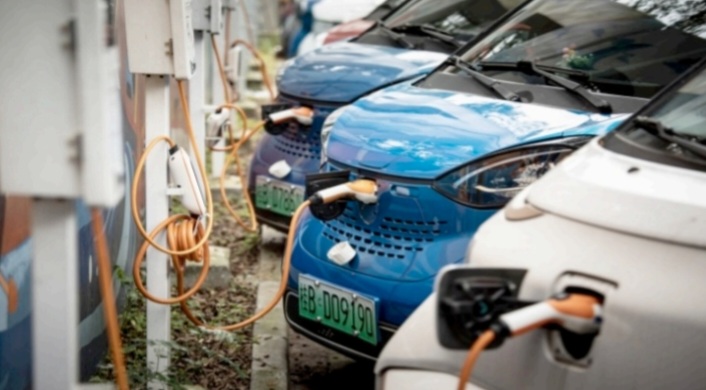Fact-Check- Does Electric Vehicles Produce More Pollution Than Gas-Powered Vehicles

CLAIM– Electric vehicles produce more pollution than gas-powered vehicles.
A recent post made by @JackTalktires on YouTube claimed that Electric Vehicles (EVs) produce green house gases one thousand eight hundred and fifty (1850) times more than gas-powered vehicles, which he stated defeats the purpose of alternative power to reduce the carbon footprint.
The post has since gathered 5,340 views; 240 likes; 115 comments; 90 shares.
https://youtu.be/L5DFJOMyPlM?si=vDXZIXMAST7tTIZt
His claim borders mostly on tyre emissions which he alleges are worse than exhaust fumes because electric vehicles weigh more due to their heavy-duty batteries. This causes their tires to wear out faster emitting tire dust as well as brake dust contributing immensely to environmental degradation. This was drawn from Emissions Analytics.
https://www.emissionsanalytics.com/ne…
NatureNews, Africa’s foremost news publications on climate change, which is dedicated to providing accurate insights to stop the spread of fake news particularly among users of social media, subjected the claim to fact checking.
Findings: Using the Google search tool in conducting this research, NatureFact, the fact checking unit of NatureNews, accessed a few papers and studies.
A thorough fact-checking investigation has revealed that this assertion is not in its entirety, accurate.
A counter, more objective analysis was given by @Donut:Nolan an environmental enthusiast who opined that he does agree that Electric Vehicles actually emit greenhouse gases up to 17 metric tons of CO2 during mining and production due to its lithium and cobalt powered batteries but he countered this by saying that what the electric vehicles emit in production, they make up for in usage as they emit no greenhouse gases during use unlike, gas powered vehicles which emit about 7 metric tons of CO2 in production, 5.2 metric tons in usage and 280 billion metric tons of CO2 from the refineries that produce the petrol that powers the vehicles.
https://youtu.be/G67i_Z8ukD4?si=zVMSMLJGxYiYKER5
These emission margins from the two vehicular motors can be verified by this app- Climobil App.
The Guardian also supports this Claim:
https://youtu.be/Chp9VlSs25c?si=LoYO5iQDjeO89J97
ADDITIONAL ANALYSIS
Electric vehicles (EVs) generally produce less pollution over their lifetime compared to gas-powered vehicles. However, the comparison depends on various factors including the source of the electricity used to charge the EVs and the production processes involved. Here’s a detailed breakdown:
Production Phase
- Battery Manufacturing
– EV batteries, particularly lithium-ion batteries, require significant energy to produce. This process can generate considerable emissions, especially if the energy comes from fossil fuels.
– Despite the higher initial emissions from battery production, the overall emissions can be offset by the lower operational emissions of EVs over time.
- Vehicle Assembly
– Both EVs and gas-powered vehicles have similar emissions during the assembly process, aside from the battery production aspect for EVs.
Operational Phase
- Emissions During Use
– Gas-Powered Vehicles: Emit carbon dioxide (CO2), nitrogen oxides (NOx), and other pollutants directly from the tailpipe.
– Electric Vehicles: Produce zero tailpipe emissions. The environmental impact depends on how the electricity they use is generated.
– Renewable Energy Sources: If the electricity comes from renewable sources like wind, solar, or hydro, the emissions are minimal.
– Fossil Fuels: If the electricity is generated from coal, natural gas, or oil, the emissions can be higher, though typically still lower than those of gas-powered vehicles on a per-mile basis.
Lifetime Emissions
- Well-to-Wheel Emissions
– Studies often use the “well-to-wheel” framework to compare emissions, accounting for all emissions from fuel production (well) to vehicle operation (wheel).
– EVs generally have lower well-to-wheel emissions than gas-powered vehicles, especially in regions with cleaner electricity grids.
- Lifecycle Analysis
– Over the entire lifecycle (production, operation, and disposal), EVs tend to have lower total emissions. The longer an EV is driven, the more its initial production emissions are offset by lower operational emissions.
End-of-Life Phase
- Recycling and Disposal
– EV batteries can be recycled, and efforts are ongoing to improve recycling technologies and reduce the environmental impact of battery disposal.
– Gas-powered vehicles also have recyclable components, but the disposal of fluids and emissions-related parts can be environmentally challenging.
Verdict– False. Electric Vehicles generally produce lower emissions over their lifetime while gas powered vehicles produce higher operational emissions due to burning fossil fuels which also contribute to air pollution and greenhouse gas emissions.
